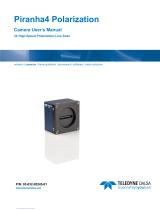
Xtium-CLHS PX8 User's Manual Installing Xtium-CLHS PX8
17
Upgrading Sapera or Board Driver
When installing a new version of Sapera or a Teledyne DALSA acquisition board driver in a
computer with a previous installation, the current version must be un-installed first. Described
below are two upgrade situations. Note that if the board is installed in a different slot, the new
hardware wizard opens. Answer as instructed in the section Installation.
Board Driver Upgrade Only
Minor upgrades to acquisition board drivers are distributed as ZIP files available in the Teledyne
DALSA web site www.teledynedalsa.com/mv/support. Board driver revisions are also available on
the next release of the Sapera Essential CD-ROM.
Often minor board driver upgrades do not require a new revision of Sapera. To confirm that the
current Sapera version will work with the new board driver:
• Check the new board driver ReadMe file before installing, for information on the minimum
Sapera version required.
• If the ReadMe file does not specify the Sapera version required, contact Teledyne DALSA
Technical Support (see Technical Support).
To upgrade the board driver only:
• Logon the computer as an administrator or with an account that has administrator
privileges.
• In Windows 7, from the start menu select Start • Settings • Control Panel • Programs
and Features. Double-Click the Teledyne DALSA Xcelera board driver and click Remove.
• In Windows 8, just type Control Panel while in the start screen, or click the arrow in the
lower left side to bring up the all applications window. Select Programs and Features, then
double-click the Teledyne DALSA Xcelera board driver and click Remove.
• Install the new board driver. Run Setup.exe if installing manually from a downloaded driver
file.
• If the new driver is on a Sapera Essential CD-ROM follow the installation procedure
described in Sapera LT Library & Xtium-CLHS PX8 Driver Installation.
• Important: You cannot install a Teledyne DALSA board driver without Sapera LT installed
on the computer.
Upgrading both Sapera and Board Driver
When upgrading both Sapera and the acquisition board driver, follow the procedure described
below.
• Logon the computer as an administrator or with an account that has administrator
privileges.
• In Windows 7, from the start menu select Start • Settings • Control Panel • Programs
and Features. Double-click the Teledyne DALSA Xcelera board driver and click Remove.
Follow by also removing the older version of Sapera LT.
• In Windows 8, just type Control Panel while in the start screen, or click the arrow in the
lower left side to bring up the all applications window. Select Programs and Features, then
double-click the Teledyne DALSA Xcelera board driver and click Remove. Follow by also
removing the older version of Sapera LT.
• Reboot the computer and logon the computer as an administrator again.
• Install the new versions of Sapera and the board driver as if this was a first time
installation. See Sapera LT Library & Xtium-CLHS PX8 Driver Installation for installation
procedures.























